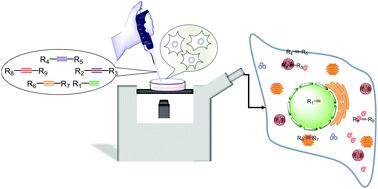当前位置:
X-MOL 学术
›
RSC Chem. Biol.
›
论文详情
Our official English website, www.x-mol.net, welcomes your
feedback! (Note: you will need to create a separate account there.)
A decade of alkyne-tag Raman imaging (ATRI): applications in biological systems
RSC Chemical Biology ( IF 4.2 ) Pub Date : 2021-07-14 , DOI: 10.1039/d1cb00116g Subha Bakthavatsalam 1 , Kosuke Dodo 1, 2 , Mikiko Sodeoka 1, 2
RSC Chemical Biology ( IF 4.2 ) Pub Date : 2021-07-14 , DOI: 10.1039/d1cb00116g Subha Bakthavatsalam 1 , Kosuke Dodo 1, 2 , Mikiko Sodeoka 1, 2
Affiliation

|
Alkyne functional groups have Raman signatures in a region (1800 cm−1 to 2800 cm−1) that is free from interference from cell components, known as the “silent region”, and alkyne signals in this region were first utilized a decade ago to visualize the nuclear localization of a thymidine analogue EdU. Since then, the strategy of Raman imaging of biological samples by using alkyne functional groups, called alkyne-tag Raman imaging (ATRI), has become widely used. This article reviews the applications of ATRI in biological samples ranging from organelles to whole animal models, and briefly discusses the prospects for this technique.
中文翻译:

炔标记拉曼成像 (ATRI) 的十年:在生物系统中的应用
炔烃官能团在不受细胞成分干扰的区域(1800 cm -1至 2800 cm -1 )具有拉曼特征,称为“沉默区域”,十年前首次利用该区域的炔烃信号可视化胸苷类似物 EdU 的核定位。此后,利用炔官能团对生物样品进行拉曼成像的策略,称为炔标签拉曼成像(ATRI),得到了广泛的应用。本文回顾了ATRI在从细胞器到整个动物模型的生物样品中的应用,并简要讨论了该技术的前景。
更新日期:2021-07-14
中文翻译:

炔标记拉曼成像 (ATRI) 的十年:在生物系统中的应用
炔烃官能团在不受细胞成分干扰的区域(1800 cm -1至 2800 cm -1 )具有拉曼特征,称为“沉默区域”,十年前首次利用该区域的炔烃信号可视化胸苷类似物 EdU 的核定位。此后,利用炔官能团对生物样品进行拉曼成像的策略,称为炔标签拉曼成像(ATRI),得到了广泛的应用。本文回顾了ATRI在从细胞器到整个动物模型的生物样品中的应用,并简要讨论了该技术的前景。









































 京公网安备 11010802027423号
京公网安备 11010802027423号